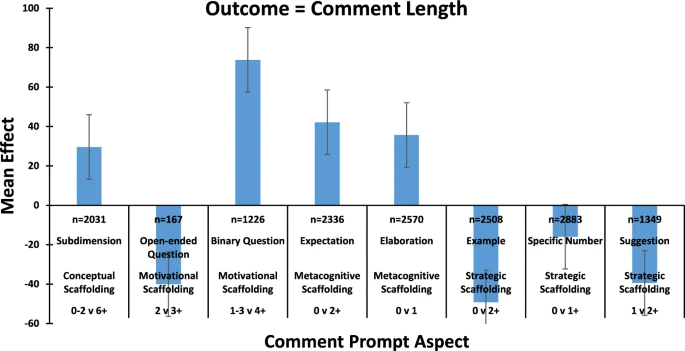New Research: Best Practices for Effective Comment Prompts

Research has consistently shown that, when done well, peer feedback is highly beneficial for learning. The challenge lies in guiding students to provide feedback that is both detailed and helpful. Dr. Schunn, Chief Learning Scientist at Peerceptiv, has been researching effective methods of peer feedback for over two decades. His latest publication examines which types of instructor-created prompts are most effective in higher education settings. Dr. Schunn’s study investigates twelve specific scaffolding features used in comment prompts and examines their impact on the length and helpfulness of student feedback, analyzing peer feedback from 281 courses across 61 institutions.
What is Scaffolding in Peer Feedback?
Scaffolding is an instructional approach where an instructor provides structured support to help students develop their skills and understanding. This support gradually decreases as students become more capable and independent. In peer feedback, scaffolding ensures students provide high-quality feedback by offering structured prompts and guidance. There are four main types of scaffolding:
- Conceptual scaffolding – Helps students focus on key aspects of an assignment (e.g., writing style, argument strength).
- Strategic scaffolding – Suggests approaches for evaluating work (e.g., identifying strengths, giving examples).
- Metacognitive scaffolding – Encourages self-reflection and awareness of feedback quality (e.g., elaboration requests, expectation-setting).
- Motivational scaffolding – Boosts engagement and persistence in reviewing (e.g., binary yes/no questions).
Research Takeaway: Specific Prompts are Better
Researchers found that conceptual scaffolding increases both comment helpfulness and comment length. Prompts should explicitly note many assignment-specific dimensions (as many as six specific subdimensions) to draw attention to those elements. For example: Provide feedback on the student’s controlled, sophisticated use of language: address its vocabulary (diction), syntax and grammar. Be specific about how the writer could improve his or her control of language and structure, and provide suggestions for improvements.


Other Key Findings: What Works in Comment Prompts?
- Use Yes/No Questions – Including at least four targeted yes/no (binary) questions improves engagement. For instance, ‘Comment on the author’s characters and plot structure. Was there anything you particularly liked about the main character? Any way the main character could have been improved? Were any scenes particularly effective? Could any scenes be improved upon, or removed? Be specific and helpful in your comments.’
- Set Expectations – Use prompts to set clear expectations around the level of feedback required. For example, ‘Provide feedback on how well the author supported his or her argument with evidence. If any evidence was inaccurate, or if any of the author’s points lacked evidence to back them up, make sure to point these out specifically and recommend how the author could improve.’
- Limit Elaboration Requests – Too many requests for detailed explanations can overwhelm reviewers. One well-placed elaboration prompt is enough.
- Skip Summaries – Asking students to summarize the work instead of analyzing it reduces the quality of feedback.
- Include Strengths Identification – Students give better feedback when asked to highlight at least one strength. For example, ‘Explain what was specifically done well.’
- Ask for Just One Example – Students provide more actionable feedback when prompted to include specific advice; however, repeatedly asking for examples, specifically with open-ended questions, may discourage reviewers from naturally providing them.
At Peerceptiv, research drives our continuous improvement. By analyzing large-scale data on peer feedback and collaborating with experts in the field, we ensure that our platform is built on proven strategies that enhance learning. We remain committed to refining peer review processes, equipping instructors with research-backed tools, and advancing best practices in feedback exchange.
Interested in applying these insights to your courses? Get started with Peerceptiv today!
Source: Mu, H., & Schunn, C. D. (2025). The good, bad, and ugly of comment prompts: Effects on length and helpfulness of peer feedback. International Journal of Educational Technology in Higher Education, 22(4). https://doi.org/10.1186/s41239-025-00502-8
Read the full research article here.